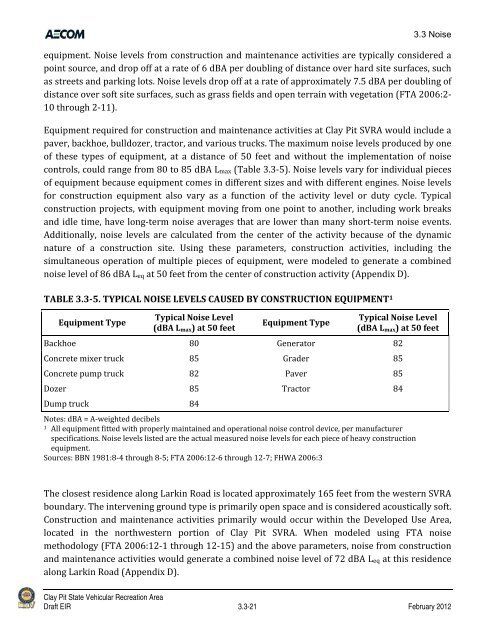Draft Environmental Impact Report - California Off Highway Vehicle ...
Draft Environmental Impact Report - California Off Highway Vehicle ...
Draft Environmental Impact Report - California Off Highway Vehicle ...
You also want an ePaper? Increase the reach of your titles
YUMPU automatically turns print PDFs into web optimized ePapers that Google loves.
3.3 Noise<br />
equipment. Noise levels from construction and maintenance activities are typically considered a<br />
point source, and drop off at a rate of 6 dBA per doubling of distance over hard site surfaces, such<br />
as streets and parking lots. Noise levels drop off at a rate of approximately 7.5 dBA per doubling of<br />
distance over soft site surfaces, such as grass fields and open terrain with vegetation (FTA 2006:2‐<br />
10 through 2‐11).<br />
Equipment required for construction and maintenance activities at Clay Pit SVRA would include a<br />
paver, backhoe, bulldozer, tractor, and various trucks. The maximum noise levels produced by one<br />
of these types of equipment, at a distance of 50 feet and without the implementation of noise<br />
controls, could range from 80 to 85 dBA Lmax (Table 3.3‐5). Noise levels vary for individual pieces<br />
of equipment because equipment comes in different sizes and with different engines. Noise levels<br />
for construction equipment also vary as a function of the activity level or duty cycle. Typical<br />
construction projects, with equipment moving from one point to another, including work breaks<br />
and idle time, have long‐term noise averages that are lower than many short‐term noise events.<br />
Additionally, noise levels are calculated from the center of the activity because of the dynamic<br />
nature of a construction site. Using these parameters, construction activities, including the<br />
simultaneous operation of multiple pieces of equipment, were modeled to generate a combined<br />
noise level of 86 dBA Leq at 50 feet from the center of construction activity (Appendix D).<br />
TABLE 3.35. TYPICAL NOISE LEVELS CAUSED BY CONSTRUCTION EQUIPMENT 1<br />
Equipment Type<br />
Typical Noise Level<br />
(dBA Lmax) at 50 feet<br />
Equipment Type<br />
Typical Noise Level<br />
(dBA Lmax) at 50 feet<br />
Backhoe 80 Generator 82<br />
Concrete mixer truck 85 Grader 85<br />
Concrete pump truck 82 Paver 85<br />
Dozer 85 Tractor 84<br />
Dump truck 84<br />
Notes: dBA = A‐weighted decibels<br />
1 All equipment fitted with properly maintained and operational noise control device, per manufacturer<br />
specifications. Noise levels listed are the actual measured noise levels for each piece of heavy construction<br />
equipment.<br />
Sources: BBN 1981:8‐4 through 8‐5; FTA 2006:12‐6 through 12‐7; FHWA 2006:3<br />
The closest residence along Larkin Road is located approximately 165 feet from the western SVRA<br />
boundary. The intervening ground type is primarily open space and is considered acoustically soft.<br />
Construction and maintenance activities primarily would occur within the Developed Use Area,<br />
located in the northwestern portion of Clay Pit SVRA. When modeled using FTA noise<br />
methodology (FTA 2006:12‐1 through 12‐15) and the above parameters, noise from construction<br />
and maintenance activities would generate a combined noise level of 72 dBA Leq at this residence<br />
along Larkin Road (Appendix D).<br />
Clay Pit State Vehicular Recreation Area<br />
<strong>Draft</strong> EIR 3.3-21 February 2012








